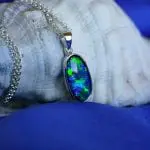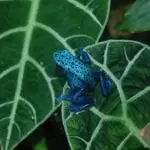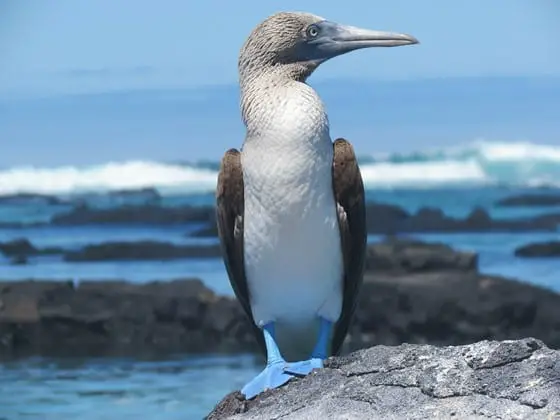
Have you ever wondered what are some of the most incredible blue objects found in nature? You will be astonished to know some of the rarest natural blue objects. One of the most incredible of them is surely the blue-footed booby.
Never heard of them? Well the mystery around them makes them worth knowing.
If you ever travel to the Galápagos Islands, a province of Ecuador, and spot some blue objects in a distance, you are sure to have sighted some blue-footed boobies. These are marine birds with unmissable bright blue legs and webbed feet and bluish facial skin. Blue-footed boobies have a white body, brown pointy wings that span an average of 52 cm. They have tapered bill with segregated edges that are bluish. This feature helps the birds to hold on to fish tightly.
It is the unique bright blue feet that make these birds so different from the other two booby species. They are probably the easiest birds to recognize.
Where are Blue-footed boobies found?
Most of the blue-footed booby population is found in the Galápagos Islands, a volcanic archipelago in the Pacific Ocean and along the coasts of Peru and Midriff Islands. These volcanic outcrops are home to some of the world’s rarest species. Some live in nearby islands, all in the Eastern Pacific coastline or the western coast of South America. Their favorite breeding ground is North Seymour. Some breeding populations of these birds can also be found in other islands including Isabela, Espanola, Baltra Island, Pinzon, Fernandina, Floreana, and Santa Cruz. These are all located south of the equator.
The chain of volcanic islands is of great importance for wildlife as they house many of the endangered species of the planet. A large area of the Galápagos is a national park. The waters surrounding the islands are also preserved and protected as a marine reserve.
How did the blue-footed booby get their name?
There are stories about how the blue-footed booby got their funny name. It is believed early explorers found their clumsy movement on land and unsuspecting approach towards humans foolish and coined this hilarious name by loosely using the Spanish word ‘bobo’ which literally means stupid. Due to their docility or not being scared of humans, these rare birds were often killed by early mariners. Considering that lack of intelligence and referring to the color of their feet, the seaman gave them the name blue-footed booby.
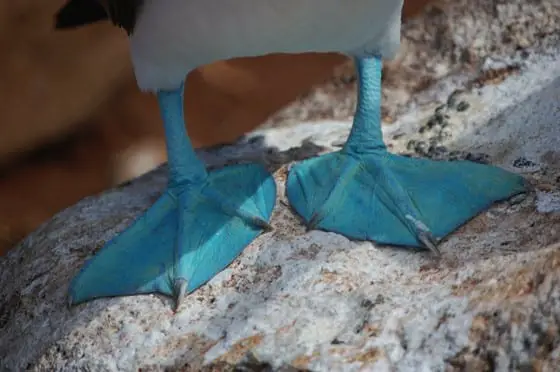
Why are the feet blue?
It is surely interesting to have attractive blue feet. Is it simply ornamental or has some significance?
· The blue feet of the this booby species come from the birds eating habits. It’s the carotenoid pigments present in the fresh fish they eat that gives the dazzling blue color to their feet.
· Brighter the blue on the handsome male feet, better are the chances of attracting a female. It has a genetic significance as the chicks they produce will have greater chances of having bright blue feet.
· The intensity of the blue hue also indicates health and immunity of the bird. It’s their feet that indicate their level of nourishment.
Habitat
The comical-looking blue-footed boobies are true seabirds and prefer to remain near the island in their tropical marine habitat rather than in the open ocean. These birds choose rocky, arid grounds of the island to nest. The lack of vegetation does not bother them. They rest and roost on any stable platform or even bare rocks.
The seagoing birds hunt for fish in the open ocean waters and come to the islands to build their nests and reproduce. The rocky, difficult to approach coastline protects them from most land and sea predators.
Behavior
Don’t let the silly look of the blue-footed booby fool you! Their clumsy moves on land do not show when they take to the sky. They are superb and agile fliers.
At daybreak, like all other boobies, the blue-footed ones take a flight to hunt for fish in the ocean. At night, they come back to the island to rest. All species of booby either fish alone or in large groups which can number up to 200 or more.
They travel great distances, to find schools of anchovies and other fish like sardines that are small. When any of the birds spot some prey they signal to the others and hunt with cooperation. Blue-footed boobies are excellent divers and their streamline body is adapted to plunging into water from a great height. It can be as high as 70-80ft (24.38 m). Not only do they dive from the sky but also when they are sitting on the water. These birds speed up when they are closer to the water and clutch the fish in their serrated beaks. They swallow as much fish as they can when underwater to maximize the hunting effort.
Feeding Habits
The blue-foot booby prefers feeding on small fish and squid. Their diet includes fish like anchovies, mackerel, and other small fish at times also flying fish. Generally, it is the larger females that dive for grabbing bigger fish. They are deep-divers and can go down as deep as 15- 65feet (19.81 m). The seabirds often also dive for feeding on discarded fish from local fishing boats.
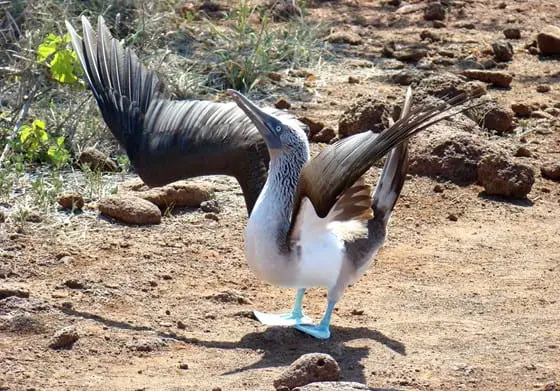
Mating Ritual and Breeding
The mating ritual of blue-footed boobies is an elaborate process where the male impresses the female with the special blue objects they have. Yes, you guessed it right! It’s their blue feet. Not once or twice, the handsome male continues the showy display of his attractive feet and wings a dozen times a day. These birds breed all around the year, following their distinct and funny courtship rituals every time.
The complicated mating rituals include a systematic process where the male performs a slow and deliberate high-stepping dance to grab the female’s attention. They fly around their territory and display the strong spread out wings followed by marching and stamping of their bright blue feet. It also includes unsteady wobble of the wings. It is always accompanied by high-pitched whistling. Often, the male also gifts the female nest building material. When a female is impressed with his performance, she may respond with a groaning call, come close, touch the male’s bill and join the dance ritual.
Nesting
Nests of blue-footed boobies are generally set on the partially rocky and sandy flat ground of the coast. The ideal spot is selected by both the partners. It is usually shaped like a bowl and ringed with guano or bird poop. The female lays 2-3 pale blue eggs in one cycle. Unlike other birds, a brooding patch (skin to keep the eggs warm) is missing from the body of the blue-footed booby. So, they use their handy blue objects, their webbed feet to keep the eggs warm. The incubation takes 41 to 45 days. Usually, each hatches with an interval of four days. The male and the female both keep the eggs warm taking turns.
Not all eggs are lucky to hatch into a chick. This species of boobies is one of the two of their kinds that raise several chicks in a single breeding cycle.
Initially, the male hunts and brings food for the chicks but later the female takes over when the demand for food is more. The parents regurgitate (first swallow and then bring up) fish to feed the young ones. They choose to feed the strong ones first to ensure at least the fittest of the brood survives. If food is scarce, the stronger ones often kill the weaker and the smaller siblings.
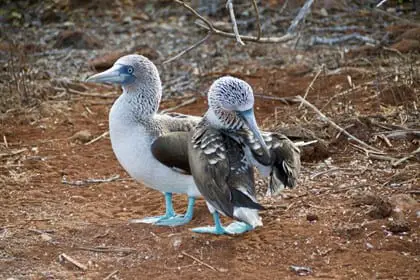
Some cool facts about the Blue-Footed Booby
- Of course, the blue feet make them most distinguishable even in a crowd! It’s an indicator of good health. Long hours of starvation can make the feet turn pale blue.
- How does the booby keep itself cool during extremely hot weather? It defecates on its feet. Yes, it does! Another way it keeps the body cool is by rapidly fluttering the skin on the throat and opening the mouth.
- The blue-footed booby does not make a nest as most birds do. It lays eggs on the ground.
- The birds make a circular boundary with excretion to mark their nest while incubating.
- Blue-footed boobies are champion divers and swimmers. To keep them safe underwater, their nostrils are sealed and shut permanently.
- These birds use their flipper-like feet not only to swim and impress the female but also to keep their chicks warm.
- Blue-footed Boobies are connected to pelicans(Pelecaniformes)
- You can distinguish males from females looking at their eyes. Males have yellow round pupils and the female have comparatively larger star-shaped pupils.
- When they attend the right age, chicks return to the same where they were born to lay eggs.
The blue-footed booby comes with a chock-full of special adaptation features that make them so interesting. The population of this amazing marine bird is considered stable. However, overfishing of the species they prefer to feed on may lead to future concerns.

